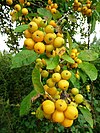
Malus is a genus of about 32–57 species of small deciduous trees or shrubs in the family Rosaceae, including the domesticated orchard apple, crab apples and wild apples.

Calliandra brevipes, the pink powderpuff, is an attractive shrub with finely divided leaves and clusters of red powder-puff flowers. It is native to southeastern Brazil, Uruguay, and northern Argentina.

Malus sieversii is a wild apple native to the mountains of Central Asia in southern Kazakhstan. It has recently been shown to be the primary ancestor of most cultivars of the domesticated apple. It was first described as Pyrus sieversii due to its similarities with pears in 1833 by Carl Friedrich von Ledebour, a German naturalist who saw them growing in the Altai Mountains.

Malus floribunda, common name Japanese flowering crabapple, Japanese crab, purple chokeberry, or showy crabapple, originates from Japan and East Asia. It may be a hybrid of M. toringo with M. baccata, in which case it would be written as Malus × floribunda.
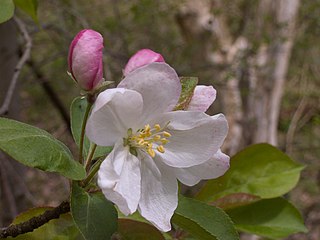
Malus coronaria, also known by the names sweet crabapple or garland crab, is a North American species of Malus (crabapple).
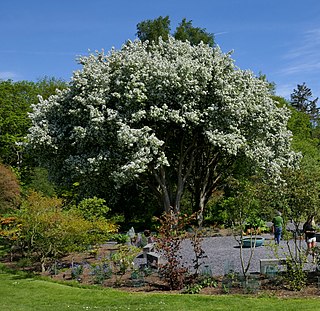
Malus hupehensis, common names Chinese crab apple, Hupeh crab or tea crabapple, is a species of flowering plant in the apple genus Malus of the family Rosaceae.

Malus fusca, with the common names Oregon crabapple and Pacific crabapple, is a species of crabapple native to western North America.

An apple is a round, edible fruit produced by an apple tree. Apple trees are cultivated worldwide and are the most widely grown species in the genus Malus. The tree originated in Central Asia, where its wild ancestor, Malus sieversii, is still found. Apples have been grown for thousands of years in Eurasia and were introduced to North America by European colonists. Apples have religious and mythological significance in many cultures, including Norse, Greek, and European Christian tradition.

Malus baccata is an Asian species of apple known by the common names Siberian crab apple, Siberian crab, Manchurian crab apple and Chinese crab apple. It is native to many parts of Asia, but is also grown elsewhere as an ornamental tree and for rootstock. It is used for bonsai. It bears plentiful, fragrant, white flowers and edible red to yellow fruit of about 1 cm diameter.
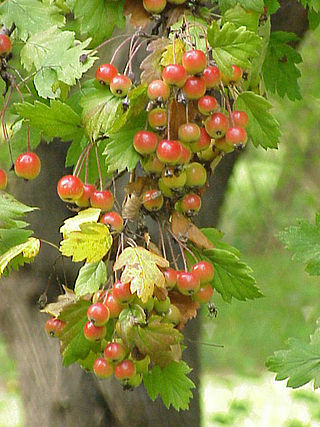
Malus florentina is a species of apple known by the common names Florentine crabapple and hawthorn-leaf crabapple. It is native to the Balkan Peninsula and Italy, and it is grown elsewhere as an ornamental tree.
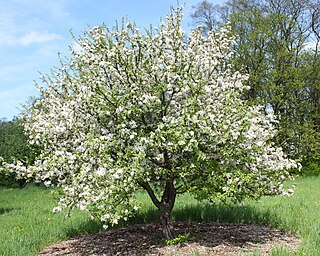
Malus prunifolia is a species of crabapple tree known by the common names plumleaf crab apple, plum-leaved apple, pear-leaf crabapple, Chinese apple and Chinese crabapple. It is native to China, and is grown elsewhere for use as an ornamental tree or as rootstock. It reaches from between 3 and 8 meters tall and bears white flowers and yellow or red fruit.

Malus sargentii, the Sargent crabapple or Sargent's apple, is a species of flowering plant in the genus Malus of the family Rosaceae. The species was formerly considered a variety of the species Malus sieboldii. It is a shrub or small tree growing to 6–10 ft (1.8–3.0 m) tall and 6–12 ft (1.8–3.7 m) broad.

Malus sieboldii, commonly called Siebold's crab, Siebold's crabapple or Toringo crabapple, is a species of crabapple in the family Rosaceae.

Malus spectabilis is a species of crabapple known by the common names Asiatic apple, Chinese crab, HaiTang and Chinese flowering apple.

Malus niedzwetzkyana, or Niedzwetzky's apple, is a kind of apple native to certain parts of China, Afghanistan, Kazakhstan, Kyrgyzstan, and Uzbekistan noted for its red-fleshed, red-skinned fruit and red flowers. Some botanists consider it a distinct species, while others have argued it is simply an unusual variety of the common apple, Malus pumila.
Applecrabs are various hybrids between crabapples and apples. They are bred for varying reasons, including disease resistance and use in cold climates because they are often hardier than apple trees and their fruit has the good eating qualities of apples.

Gaudium brevipes, commonly known as the slender tea-tree, is a species of shrub or small tree that is endemic to eastern Australia. It has fibrous bark on the main stems, smooth bark on young stems, narrow elliptical to narrow egg-shaped leaves, white flowers and hemispherical fruit that is shed when mature.

Malus × robusta, called Siberian crab apple along with other members of its genus, is a hybrid species of flowering plant in the family Rosaceae. It is the result of a cross between Malus baccata and Malus prunifolia. It is being studied for its resistance potential to fire blight. Known for its attractive fruit that remain on the tree well into winter, its cultivar 'Red Sentinel' has gained the Royal Horticultural Society's Award of Garden Merit as an ornamental.


















